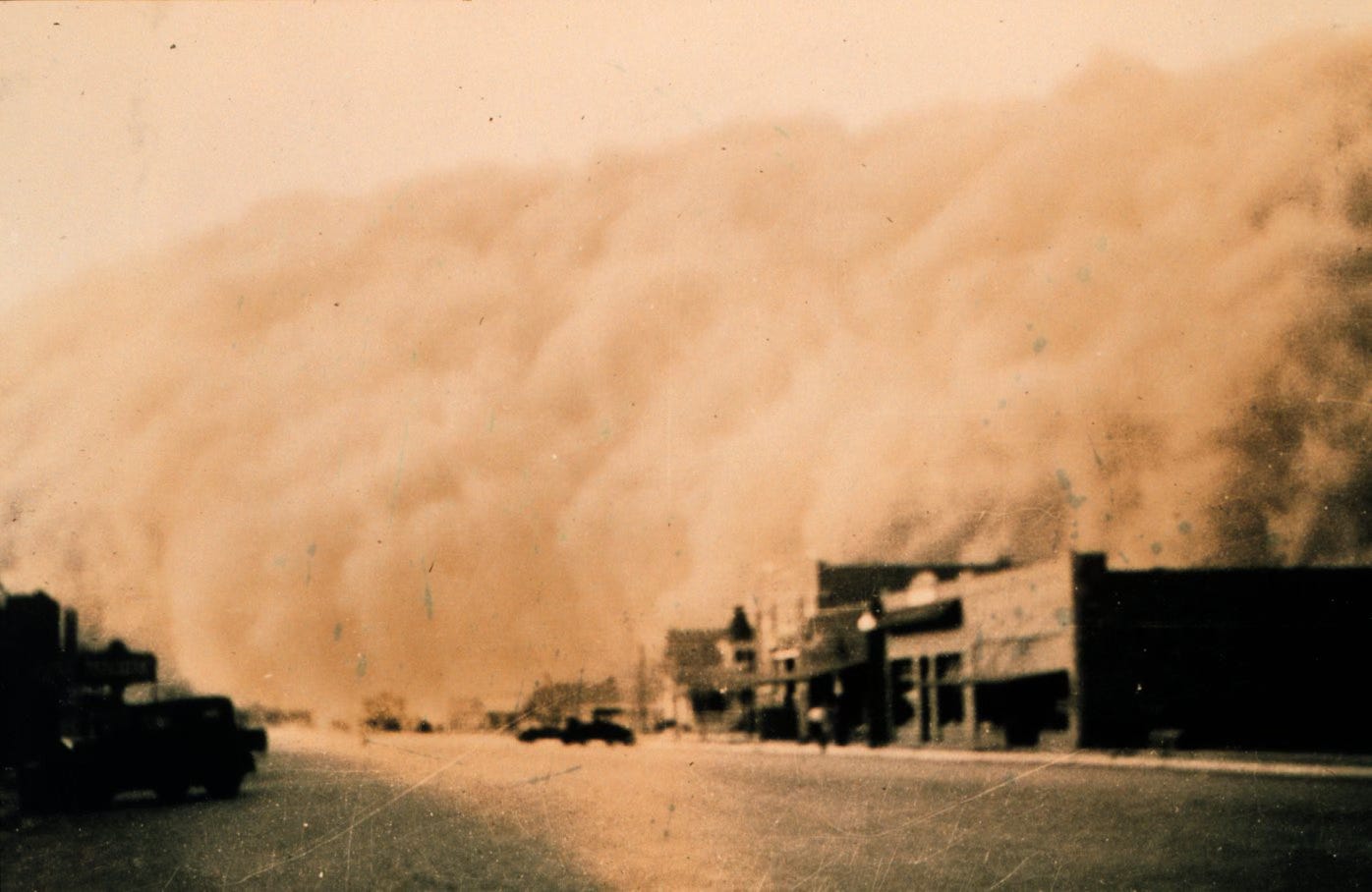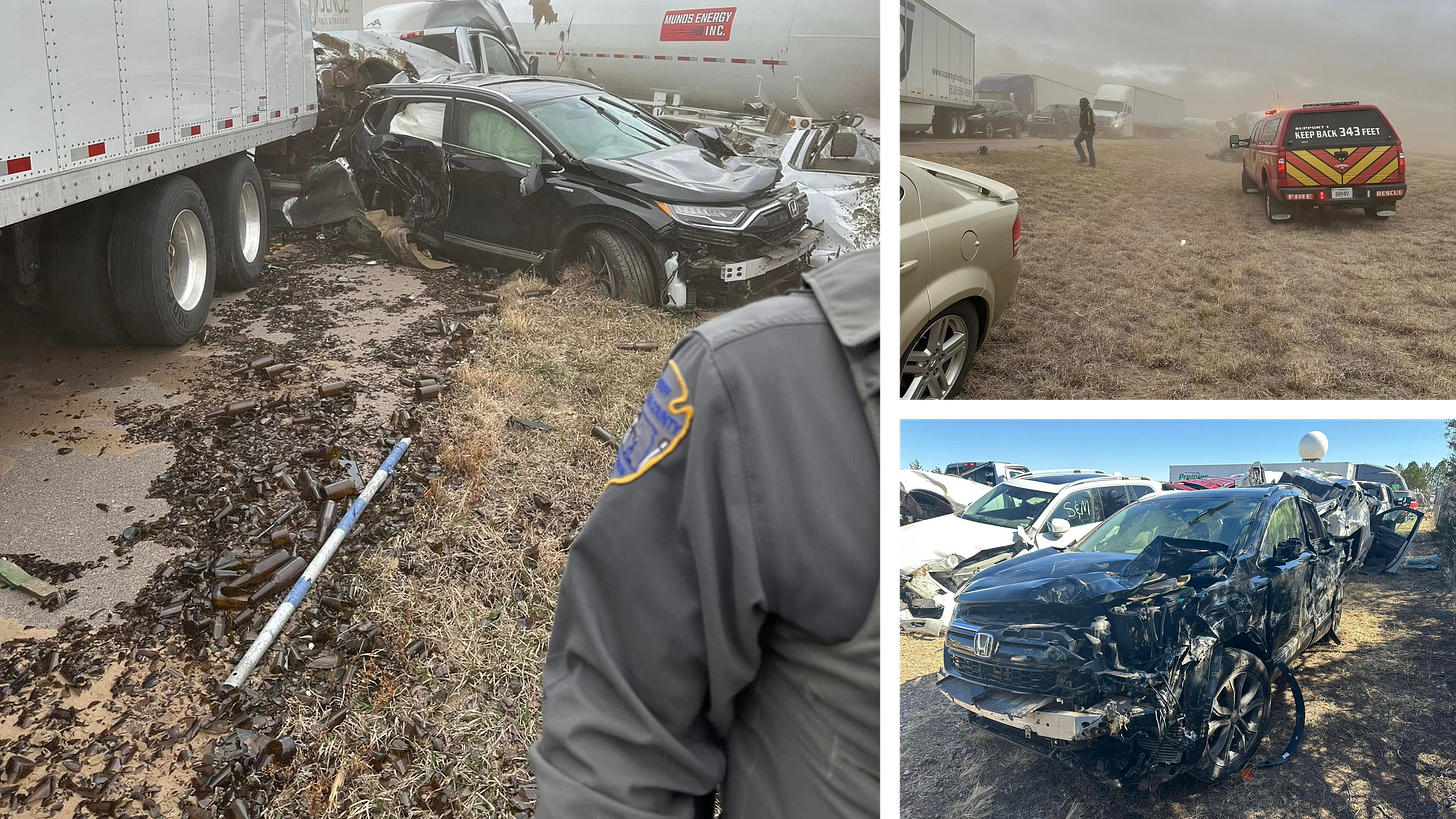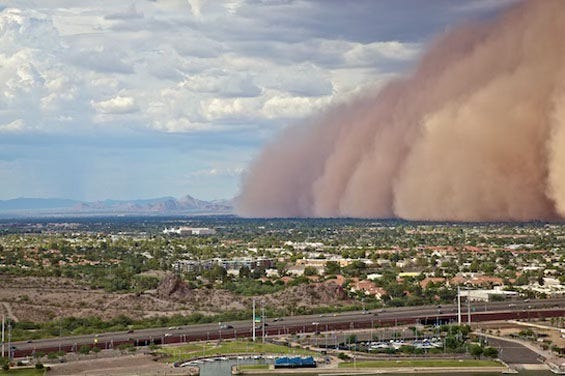
Because despite the funny word, dust storms are deadly serious.
Longtime LauraPalooza attendee and Ingalls researcher Patty Dowd Schmitz narrowly escaped a tragic outcome during a “black blizzard” in western Kansas on March 14. Hers was one of 71 cars involved in a pileup on Interstate 70 near Goodland that left eight people dead. Schmitz, her partner, and her dog survived multiple collisions, escaping from a total car with minor physical injuries. I’m stunned at her brush with tragedy and grateful she lived to tell her story. Dust storms can bring visibility to zero in just seconds, with road markings and taillights and other vehicles ahead nearly impossible to see.

Dust Storms Past and Present
Dust storms can cover a small patch of ground or half a state. Particles of dust lofted on the winds stir up tens to hundreds of feet above the ground. A few particles of dust will sting the skin and eyes, maybe reduce visibility to a mile or so, and barely cause notice. Intense dusters can sweep through half a state of land, bring visibility down to a quarter mile or less, blot out the sun, and cause health hazards when people inhale the dust. Dust storms can cause traffic pile-ups and eye injuries.
Two areas of the United States are particularly vulnerable to dust storms: the desert Southwest and the High Plains. In the desert Southwest, dry seasons are a normal part of the climatology, with very little precipitation for several months in the spring and summer. High winds from dry storm systems stir up the desert dust and carry it over interstates or into major cities. Often intense, with visualities dropping near zero and expanding across several miles, these dust storms are the ones often labeled “haboob”: an intense dust storm. The word haboob originates in Sudan, in the Sahara desert and also prone to intense dust storms.

Dusters also dot the High Plains landscape in dry years. The extreme example is, of course, the Dust Bowl of the 1930s, with repeated intense dust storms from eastern Colorado, western Kansas, and western Nebraska down into eastern New Mexico, western Oklahoma, and western Texas. Iconic pictures, like the one at the top of this note, capture a billowing wall of black dust swallowing towns, farms, and roads. Dust in the 1930s originated from tilled, dry farm fields. With no vegetation to hold down the soil, the loose dirt lofted on the winds common to the Plains, depositing dirt hundreds and sometimes thousands of miles from its origins. An estimated one billion tons of soil blew away on the winds in the 1930s, and only through intensive land management efforts has the Plains managed to hold onto its soil in the hundred years since the Dust Bowl.
Even so, Plains dusters still occur, especially in dry years. Generations have passed since the Dust Bowl era, and as each generation passes and as commercial agriculture overtakes family farming, the memory of the Dust Bowl fades. That shelterbelt of trees planted in a row in the 1930s to break the wind and keep soil in place starts to look like an impediment to plows and a chunk of land that could be acreage for more crops. Drought years are a part of the Plains climatology, and those years will always be prone to dusters. Good soil conservation and crop management practices will help minimize the number and severity of dust storms, though.
As droughts increase in frequency and intensity in the High Plains and desert Southwest, those areas will become even more prone to dust storms. Other parts of the country that aren’t used to dusters will experience them as their droughts increase, too. In May of 2023, a rare dust storm in Illinois caused a pileup on Interstate 55 involving dozens of vehicles that also left eight people dead. Especially for people who travel, it is important to know what to do if caught in a duster.
Dust Storm Safety
If you find yourself venturing across the highways and into a black blizzard, the National Weather Service provides these safety tips:
If dense dust is observed blowing across or approaching a roadway, pull your vehicle off the pavement as far as possible, stop, turn off lights, set the emergency brake, take your foot off of the brake pedal to be sure the tail lights are not illuminated.
Don't enter the dust storm area if you can avoid it.
If you can't pull off the roadway, proceed at a speed suitable for visibility, turn on lights and sound horn occasionally. Use the painted center line to help guide you. Look for a safe place to pull off the roadway.
Never stop on the traveled portion of the roadway. (NOTE FROM DR. BARB: THIS IS EVERGREEN ADVICE FOR ALL WEATHER HAZARDS!)
Why turn off your lights? Because someone might see your lights on and think you’re still traveling, then drive off the road or run into your car!
Driving into any rapid reduction in visibility is dangerous, whether it is caused by a snow squall, downpour, fog, or dust. The best way to be safe is to avoid them. Monitor the forecasts along your route to know when these dangerous conditions are in the forecast. Be as flexible as you can with your travel plans - consider leaving early or late or traveling an alternate route. Use weather apps to stay aware of what lies ahead.
This Month in Wilder Weather History
April 2, 1889: A prairie fire, masked by a dust storm, threatened the young Almanzo and Laura’s homestead north of De Smet, South Dakota. Widespread prairie fires in the eastern Dakotas on April 1-2, 1889, burned a half million to a million acres, destroying numerous buildings and affecting several eastern Dakota towns. A dry spring and summer of 1888 and mild winter in 1888-1889 left the prairie covered in cured grasses and topsoil dried and easy to loft. Winds described as “hurricane force” - reportedly 60 to 80 mph - whipped dust into the air and small fires into conflagrations.




I always learn something new in your newsletters Dr. Barb. Pulling off the road and turning OFF all lights in a dust storm is something I'm not sure I would have considered. I'm familiar with strong winds and blowing desert dust, having driven between California and Tucson many a time. I've never experienced a haboob, but I've had a few close calls with errant tumbleweeds. Thanks for the important public service message.
Dust or Sand - did you hear about the sandstorm in Alaska earlier this month?
https://www.alaskasnewssource.com/2025/03/06/iditarod-53-mushers-dogs-regroup-tanana-after-sandstorm-flings-silt-near-river/